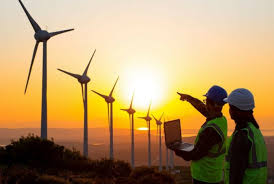
A new report by the Environmental Defense Fund claims wind and solar energy jobs now outnumber coal and gas jobs in 30 U.S. states, including Washington, D.C.
Despite the dramatic increase in wind farm operations in Oklahoma, Kansas and Texas, they are not among the 30 states cited by the EDF. None of the major oil and gas states including New Mexico, Colorado, Wyoming, Montana, Louisiana and North Dakota are ranked in the top 30.
The report, “In Demand: Clean Energy, Sustainability and the New American Workforce,” finds that the clean energy and sustainability economy provides local jobs in all 50 states, frequently pays higher-than-average wages, and offers numerous career and educational pathways, says EDF.
“The clean energy workforce has skyrocketed, launching us into the new clean energy economy while supporting American workers,” says Ellen Shenette, manager of EDF Climate Corps, a summer fellowship program that accelerates clean energy initiatives and spearheaded the new report.
The report says the U.S. renewable energy sector employed 777,000 people at the beginning of 2017 – roughly as many as in the U.S. telecommunications industry. Notably, these renewable energy jobs outnumber coal and gas jobs – at more than 558,000 – by nearly 1.5 to 1.
At 48%, bioenergy (biofuels, biomass and biogas) is the largest employer of renewable energy jobs, while solar is second at 33%. Wind energy comes in third place at 13%, while geothermal and small hydropower account for 5% and 1%, respectively. For wind and solar particularly, Texas and California employ the most workers, the report adds.
By 2020, the report predicts that Texas, Colorado and Iowa will each have more than 15,000 wind jobs. In addition, North Dakota, Minnesota, Illinois and Ohio are expected to have 7,500-15,000 wind jobs.
The report, co-authored by Meister Consultants Group, a Cadmus Company, notes that 2017 marked a year of political uncertainty at the federal level: It centered on the future of renewable energy tax incentives and the potential tariff on imported solar modules. (The Trump administration’s final decision to approve 30% solar tariffs came on Monday.) In turn, at the end of 2017, there was a 22% decrease in cumulative solar installations compared with last year’s numbers, says EDF.
However, the report, citing numbers from the Bureau of Labor Statistics, projects that solar PV installers and wind turbine service technicians will be the two fastest-growing jobs in America from 2016 to 2026, roughly doubling during that period. In addition, EDF says solar and wind installations comprised 65% of installed electric capacity in 2016, and for the third year in a row, they exceeded the installed capacity of all other electricity sources combined.





